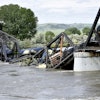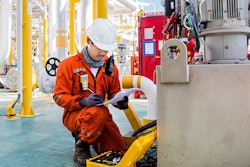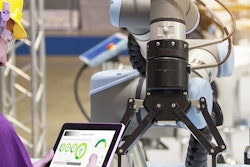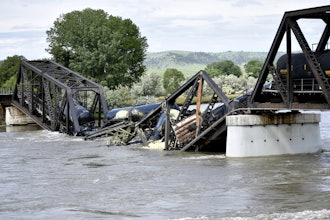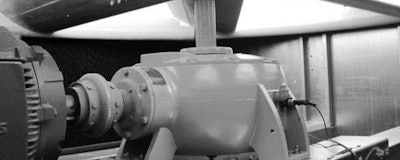
Many service contractors and cooling tower owners take a reactive approach when it comes to maintenance and repair. They replace a component only after it breaks, or they contact someone to perform a repair when a component failure is imminent. By proactively following manufacturers’ user manuals and employing checklists and guides to track the condition of equipment and components, maintenance personnel will extend cooling tower life, achieve peak performance and minimize the chance for unplanned equipment breakdowns. Comprehensive cooling tower inspection is essential—but, ideally, it should be paired with a preventive maintenance schedule to achieve better results.
 A maintenance service call often begins with an inspection of the drive train. Because a drive train does not always exhibit clear-cut issues, thorough inspection is a must.
A maintenance service call often begins with an inspection of the drive train. Because a drive train does not always exhibit clear-cut issues, thorough inspection is a must.Inspect Cooling Tower Mechanical Components
A maintenance service call often begins with an inspection of the drive train, which is most subject to wear and tear. The drive train typically consists of the gearbox, motor, and coupling. Because a drive train does not always exhibit clear-cut issues that signal maintenance or repair, thorough inspection by an experienced professional is a must. If he or she practices preventive maintenance techniques—bonus points.
Mechanical components require routine inspection, per manufacturers’ guidelines, to ensure they are properly lubricated, aligned or tensioned. Proactively identifying when a drive train is operating outside optimal performance parameters is a key skill for mechanical contractors.
For example, the technician may routinely check motor and gearbox alignment, gearbox oil level, and signs of oil leaks. To prevent more serious gearbox issues, vibration levels can also be checked to provide signs of the mechanical system’s condition. The frequency and amplitude of this vibration can be measured and analyzed to provide additional insights into whether the drive train components require repair or replacement.
Contractors and maintenance managers should verify that all tower components are functioning correctly and performing well:
- Check fan pitch and adjust fan blades as needed.
- Visually inspect the heat transfer fill. If excessive scale buildup or biological fouling is present, clean or replace the fill.
- Make sure nozzles and flow valves for makeup water are not clogged.
- Clean the cold water basin, removing any dirt, debris or signs of biological growth. Enlist the services of a water treatment professional and confirm that an effective water management plan is in place, per ANSI/ASHRAE Standard 188 and Guideline 12.
 Heat transfer fill with excessive scale buildup should be cleaned or replaced.
Heat transfer fill with excessive scale buildup should be cleaned or replaced.Keep Cooling Tower Control Systems In Check
The new generation of electrical control technology for cooling tower components — including those for vibration switches, basin heaters and variable frequency drives — also require trained specialists. A service technician may be an expert in mechanical components, but less familiar with controls and electrical systems. Maintenance contractors are wise to invest in training technicians, so they can install and diagnose control systems along with mechanical components.
Controls specialists check conditions for several cooling tower systems to confirm:
- The basin heater warms the basin to the recommended temperature, as necessary for cold weather operation.
- Water in the cold water basin is at the recommended level and measured accurately.
- The vibration switch is operating properly. A visual inspection of the cooling tower’s mechanical equipment is advised to address causes for excessive vibration before restarting operations and resetting the switch.
- A variable frequency drive (VFD) and other control systems are accurately monitoring and controlling cooling tower operation.
The key takeaway is that technicians must stay current with the mechanical equipment and controls used in cooling towers and be aware of industry trends. Both service technicians and cooling tower maintenance personnel should actively pursue educational opportunities and technology updates, from hands-on training sessions to online videos and tutorials provided by OEMs.
Implement a Water Management Plan
Cooling tower hygiene is an important part of preventive maintenance, especially with increasing oversight by government agencies and ASHRAE standard recommendations. Per ASHRAE Standard 188, it is important to develop a proactive water management plan that incorporates
monitoring and testing to prevent conditions that encourage scaling, corrosion and microbial growth.
Service contractors may find signs of corrosion, scale or other foreign matter during their inspections and call attention to these areas, but many contractors do not directly handle water chemistry issues. Cooling tower owners must continuously address water quality directly with a qualified water treatment provider.
Water treatment professionals utilize a variety of instrumentation and tools to monitor and maintain cooling tower water conditions. Cooling tower owners may also monitor water usage through metering programs to help reduce water consumption.
 Controls specialists check conditions for several cooling tower systems, including the vibration switch, to ensure it is accurately monitoring cooling tower operation.
Controls specialists check conditions for several cooling tower systems, including the vibration switch, to ensure it is accurately monitoring cooling tower operation.Minimize Equipment Failure with Careful Inspections and Preventive Maintenance
In facilities where cooling tower performance and reliability are imperative to operational success, cooling tower owners often invest in a preventive maintenance contract that includes regular inspections and maintenance. While preventive maintenance plans do not completely eliminate the chances for component failure, they minimize occurrences of unplanned equipment breakdown. Properly maintained equipment will operate more efficiently and cost effectively than equipment operated to the point of breakdown.
Regardless of whether a service contractor is involved, equipment operators should follow the cooling tower manufacturer’s inspection and maintenance recommendations outlined in the user’s manual. An independent contractor may be hired to inspect and service a cooling tower once or twice a year, but some components require more frequent service intervals. A combination of efforts between the service contractor and owner’s maintenance team is needed to achieve the most optimal preventive maintenance results.
Checklists are an important aid in guiding maintenance personnel during cooling tower inspections. With a checklist and past inspection records, facility operators can effectively document issues that require immediate attention or should be monitored for future action.
Some best practices for conducting inspections include:
- Having a working knowledge of cooling tower components and ancillary control systems.
- Reviewing manufacturer’s user manuals prior to inspection.
- Employing a checklist or inspection applications to organize findings. Mobile apps and other inspection software allow contractors to immediately record, store and organize data during the inspection process and immediately send inspection reports to cooling tower operators.
- Being thorough and methodical in reviewing cooling tower components.
- Making note of initial observations about components or conditions that appear worn or out of spec.
- Being specific about findings and recommendations; clearly spell out corrective actions and next steps. Provide estimates for repair and replacement.
 A qualified water treatment provider may recommend an automated chemical delivery system to maintain cooling tower hygiene, important for addressing ASHRAE Standard 188 and preventive maintenance.
A qualified water treatment provider may recommend an automated chemical delivery system to maintain cooling tower hygiene, important for addressing ASHRAE Standard 188 and preventive maintenance.Inspection reports can help document the overall condition of the tower and its specific components. This will help the customer identify immediate maintenance needs and budget for future needs recommended in the report. Always refer to the manufacturer’s user manuals for guidance and contact your technical representative should you have questions or need further direction.
Cooling towers, when well maintained, do not require frequent, complicated or costly maintenance. As long as tower owners and service contractors collaborate regularly and commit to regular preventive maintenance, cooling towers will operate efficiently for decades.
David McDaniel is the Digital Vice President of Sales, and Robert Swafford, SPX Cooling Technologies OEM Parts Manager.



